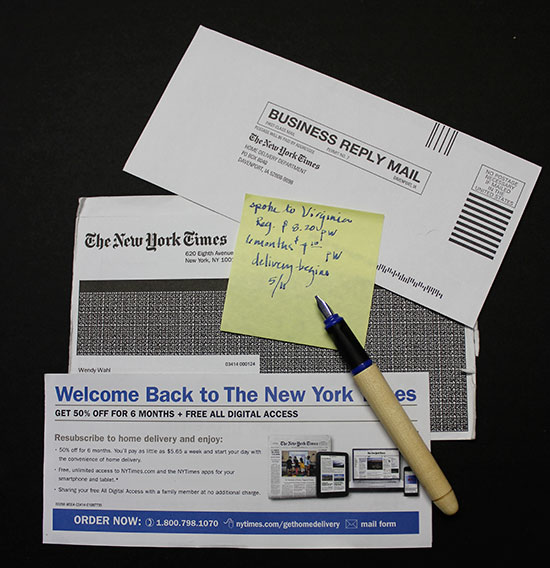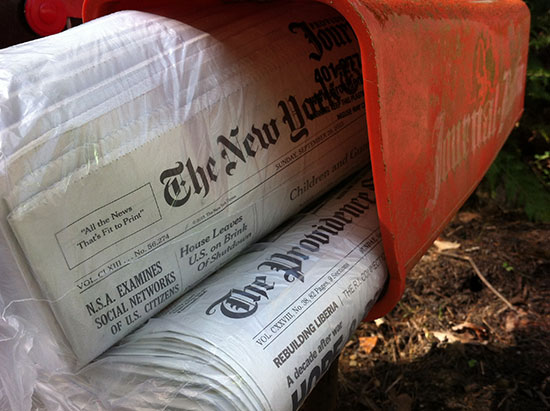The following story describes an obsession with a newspaper that some people may take for granted. Perhaps at one point this desire was heightened because I had been included in the paper’s folds.
As I took the 106 steps from an east door of my home I focused on the sensation of my feet walking across the recently laid pavers, onto the gravel drive and through a break in the stonewall to the street to see if it had really arrived. I had waited over 20 years for this moment and I savored each stride with anticipation that was punctuated with my own sounds of excitement. Patient hopefulness described my wait to unfold the neatly layered sections to discover what was inside. Though I feared it wouldn’t be there like so many times before and all my expectations would be shattered, I still felt somehow today was different.
For several years I would get in my car and travel the approximate 10 miles roundtrip to Taylor’s Country Store where I had reserved my copy of the paper. Back then Taylor’s could be described as a charming, dusty, ramshackle, screen-door-hits-you-on-the-way-in-and-out kind of place. The entrance was so close to the two-lane main road that when you pulled up to park in the allotted space you’d be lucky not to hit anything or anyone. Inside the store was something you had to physically experience. There was nothing there I would eat; many of the product expiration dates had been reached and much of the packaged food was unrecognizable. It was one of the few destinations between my house and pretty much anything else heading east towards the University of Rhode Island just beyond the Kingston train station. The store marked the north end of the Great Swamp. Mom and Pop Taylor were the quintessential shopkeepers who were humorously kind. I would usually run into someone I knew there. Around the same time the Department of Transportation took out the rotaries aka suicide circles on Route 138, Taylor’s closed. The Alternative Food Co-op moved in which I welcomed having nearby because you could purchase fresh, local fruits and vegetables, eggs and dry foods in bulk. An Asian Market followed this that brought lemongrass, tamarind and an array of new flavors to my neighborhood; a delicious culinary addition to rural South County but neither carried the newspaper I wanted to wrap up in at least on the weekend.
In 1990 I contacted The New York Times to see if I could get the paper delivered. I was instructed to fax my order in. If you remember this was a time when answering machines were being challenged by the immediacy of the fax machine. I saw it as the thin edge of the personal communications wedge. After getting no results from my requests via this technology I picked up the telephone, not a smart phone or a cordless, but a copper connected landline and made the call to the subscription office to create an account to get the paper delivered to my doorstep. The person on the other end of the phone seemed genuinely helpful to include me in the community of those who wake up to find “all the news that fit to print” within arms length. The representative took my name, address and credit card information and told me that I should expect to wait 4-6 weeks for my first delivery. I immediately put the expected date into my day-at-a-glance book and waited with great expectation. I probably don’t have to tell you that it didn’t arrive and oddly enough they started to send subscriptions advertisements. When I called to find out what happened the explanation was that “currently there isn’t delivery of the Sunday Times in your area.” I was told it could be mailed and I may receive it on Wednesday or Thursday. Seriously?
Geographically Rhode Island isn’t that far away from New York and the whole state is the size of the county of Los Angeles. Myself a native Angelino, I often think of the avocado and loquat trees that dotted the landscape and how the Santa Monica Mountains terminate at the sea. My thoughts drift to a time where the scent of citrus from the fruit groves lingered in the air after passing through the San Gabriel valley on a two-hour drive to the snow-covered San Bernardino range. I still remember the importance of our first RCA color console. The latest in home technology that aired Walter Cronkite every evening, the Jetsons on Saturday mornings and the Ed Sullivan show on Sunday night but this didn’t change home delivery of several newspapers that were available at the time. Looking back, it was an era of door-to-door sales of print subscriptions that included magazines, books and in our case the newspaper from the Big Apple. I mistakenly assumed I could receive The New York Times delivered in New England. Now I understand that even by Rhode Island driving standards I’m off the beaten track. In order to get to where I live you have to travel off the main east west artery of the state passing through turf fields, an Audubon preserve bordered by a white pine forest, cross over a one lane bridge, go past a pottery up a winding hill and at the time down an unpaved road to arrive at the last house whose postal address was a rural route and where three town lines intersect in the road in front of the house. I explained to the representative whom I hoped had a sympathetic ear that it was only two-and-a-half miles off the main road. The representative told me there just weren’t enough people who wanted delivery in my neck of the woods. I asked if they would just leave it at the end of the road so I could pick it up there. They stopped sending notices.
A new rhythm developed where I would call the toll-free subscription number every few months to go through the motions of creating an account only to be met with the same results. After the millennium my efforts dwindled to every six months and then perhaps once a year. Then suddenly sometime in 2007 they began to send offers again letting me know that delivery was available in my area. I took the bait each time over and over again. I was delighted to see my invitation to get home delivery and at an introductory price of 50% off in my mailbox. I would dutifully fill out the form, repost it and back it up with a call where I would be informed that in fact it would be on its way. Yes, it’s finally happening – I’d dance about and sing hallelujah! My husband would look at me with a raised eyebrow “are you going to fall for it again?” Always hopeful, my response was “indeed.” But as you can guess, it didn’t happen. To my family I must have seemed so pathetic to continue on this ridiculous ride for years. Eventually I stopped responding to the solicitations giving up on the prospects of it ever happening. However, in early April last year I received a notice in the mail from the subscription office that delivery was available. I thought, what have I got to lose? I called.
Admittedly I’d become relatively skeptical but perhaps this was the moment – the time had arrived when I would actually be able to get it delivered. If this sounds like a promotional ad for The New York Times, perhaps it is. Drum roll please…last year on a Sunday morning in May I went to my Providence Journal box where I had requested the Times be placed, a logical idea since both papers are now printed and delivered from the same location, to see if it was there and it was! It would have been enough that it arrived at all but it was Mother’s Day and it had the Travel of the Times magazine – armchair candy. So pleased to have the newspaper in my hands I began separating the paper by quickly scanning and then for the moment setting aside the front page because it’s too grim to take in the global inequities so early in the day. The striking contrast of headlines and stories to the needed advertisements to keep it printed is unsettling. I move on to the SundayReview, my favorite section, where I’m confident I will discover something that will inform my work. That week I was introduced to Alice E. Kober, the instrumental backstage player in deciphering Linear B, “an unknown language in an unknown script” as described by linguist Margalit Fox author of recently released The Riddle of the Labyrinth: The Quest to Crack an Ancient Code. It made me think about lost civilizations. In that same section was a news analysis titled The Hidden World Under Our Feet. As a mycophile and tree hugger it caught my eye. Jim Robbins articulates the idea that “the world’s ocean of soil is one of our largest reservoirs of biodiversity” and that “the complex soil ecosystem is highly evolved and sophisticated”. His new release The Man Who Planted Trees (different from the book with the same title by Jean Giono, published in 1953 and I suspect inspired by) documents one nurseryman’s quest to clone the biggest trees on the planet in order to save our forests and ecosystem. I’m feeling gratified for all my efforts. Then it’s on to each section: Arts and Leisure, Travel, BookReview, SundayBusiness, SundayStyles, SportsSunday, and the Magazine where I’m puzzled, challenged and humbled by Will Shortz. Unfortunately the New England edition doesn’t have a classified section. Nostalgia wafts in on a zephyr and I can see my father in his plaid wool robe sitting at the kitchen table, the overhead fixture illuminating the plate of peanut butter filled celery troughs and his reflection in the sliding glass door, reading the want ads out of curiosity. For me some weeks the paper is devoured the day it arrives and is then left lying about the house and studio to be reread and reused. There is something so comforting about curling up on the sofa or sitting at the round table with a really good newspaper. I enjoy the feel of it between my fingers, the smell of the ink and that familiar font that I now need magnifiers to read.
Newspapers have many uses beyond their primary function to communicate information and ideas. Among these the most intriguing is as a medium for making art. Picasso immediately comes to mind as appropriator of the material. In 1909, Fillippo Marinetti coerced Le Figaro to print his controversial manifesto promoting the Futurist movement. In the 21st century Jim Hodges covered a newspaper from Amman, Jordan in 24k gold. An exhibition celebrating the relationship between newspapers and the arts titled Shock of the News at the National Gallery of Art in Washington, DC documents these and many other 20th century artists using newspaper as a medium for the message. Print-Inspired Art: All The News That’s Fit To Paint : NPR .
I embrace the reality of digital access to information at my fingertips like a library on the desktop – when the technology is working. Recently while scrolling through the TED Talks I came across a presentation by Jacek Utko, a Polish newspaper designer and former architect who is questioning the notion that newspapers can be saved by reconnecting readers through good design and content choices. Something along the lines of form follows function. www.ted.com/…/jacek_utko_asks_can_design
Now as I walk back to my house carrying the newspapers each week I feel a sense of relief in finally having The New York Times delivered directly on Sunday. Unfortunately sometimes this feeling is too quickly followed by the fear that now that I can have it delivered it might go out of print altogether and soon not be physically delivered anywhere.
February 12, 2014



